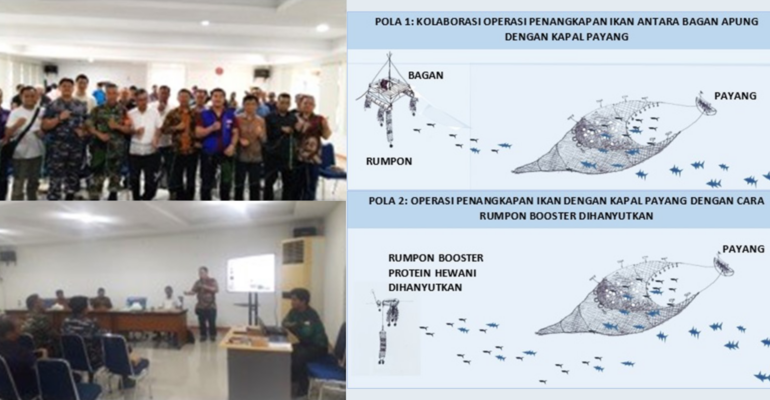IPB University PSP Lecturers Socialise Animal Protein Booster FADs to Payang Fishermen in Palabuhanratu

The IPB University Dosen Mengabdi Inovasi (DMI) team from the Department of Fisheries Resource Utilisation (PSP), Faculty of Fisheries and Marine Science (FPIK) held a community empowerment activity for boat seine fishermen.
In the activity, IPB University lecturers introduced the innovation of animal protein booster FAD technology to a number of parties, ranging from government agencies, business actors/capture fisheries companies and owners/fishermen of drift gillnets and drift gillnets, including members of the Harapan Kita Bina Nusantara Palabuhanratu Joint Business Group (KUB).
The Innovation Service Lecturer team consisted of Dr Zulkarnain, Dr Wazir Mawardi, Dr Ronny I Wahju, Dr Fis Purwangka and Ende Kasma, SPi, MSi as the technician of the IPB University Marine Field Station.
“This is one of the mandates of the tridarma of higher education and the PSP Department of IPB University is always ready to synergise with capture fisheries stakeholders in Palabuhanratu,” said Dr Zulkarnain, leader of the lecturer team.
He added that his team is committed to providing access to information on the development of science and technology that has been produced by the campus. The effort is also to disseminate technological innovations resulting from the research of IPB University experts to the fishing community to be able to increase fish catches and at the same time increase fishermen’s income.
Furthermore, Dr Zulkarnain explained, animal protein booster FADs are included in the classification of fishing aids (ABPI) to attract and collect fish and then be caught easily by the fishing gear used by fishermen.
“Animal protein booster FADs can be used for various fishing gears (gear-specific) which will be adjusted to the technical aspects of fishing gear construction and operation,” he explained.
“Animal protein booster FADs are the result of previous research development and we have disseminated them to floating bagan and handline fishermen in Palabuhanratu Village. The percentage increase in fish production reached 165 per cent and 58 per cent respectively,” said Dr Zulkarnain.
According to him, animal protein booster FADs have the same chance of success to provide an increase in fish catch on drift gillnets in Palabuhanratu. The gathering of small fish close to the surface of the water will bring out other groups of medium and large fish to prey on the small fish at the surface of the water.
“The appearance of fish on the surface of the water is a very big chance that the seine boat will get a catch,” he added.
Dr Zulkarnain explained that there are two alternative patterns for the use of animal protein booster FADs in daytime fishing operations. The first is collaboration with floating masts as a base for the placement of animal protein booster FAD construction that can be utilised by floating masts at night and seine boats during the day.
“The second utilisation pattern is only carried out by the seine boat by drifting the animal protein booster FADs under the control of the seine boat while paying attention to the appearance of fish on the sea surface,” he explained. (*/Rz) (IAAS/RUM)



